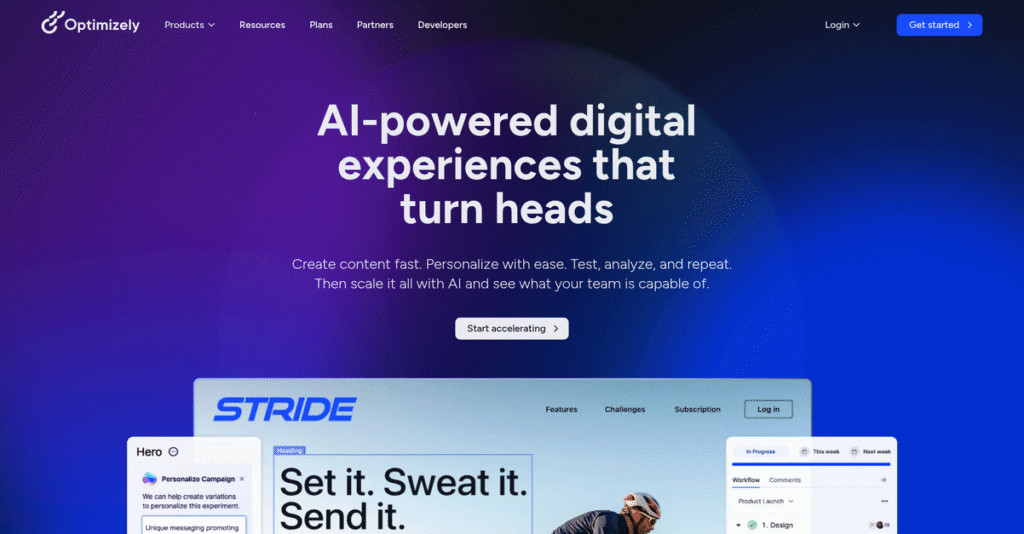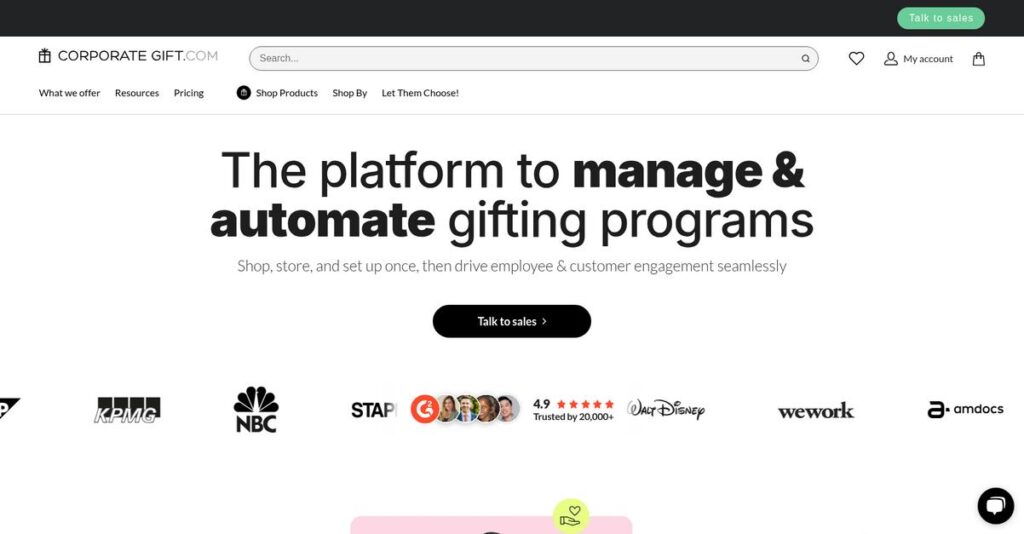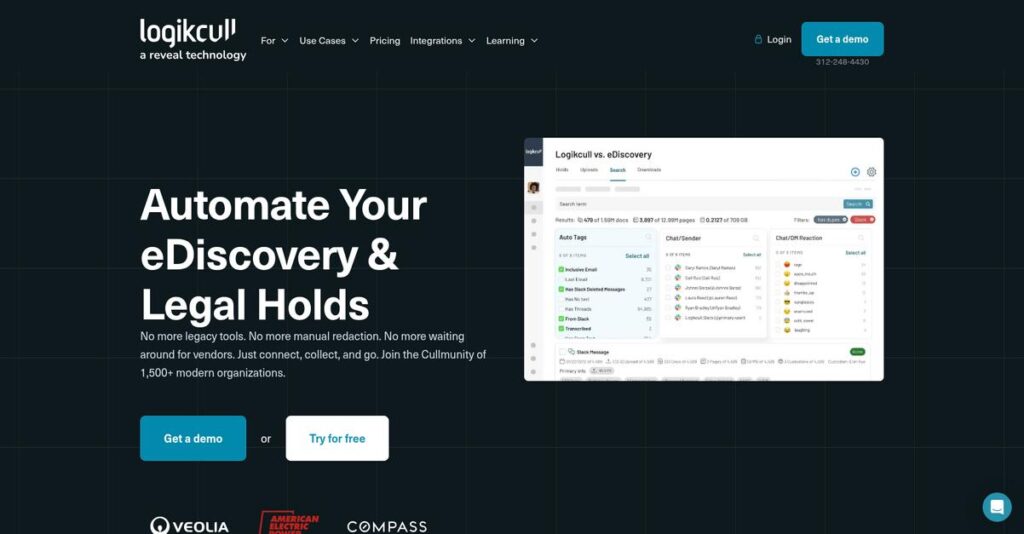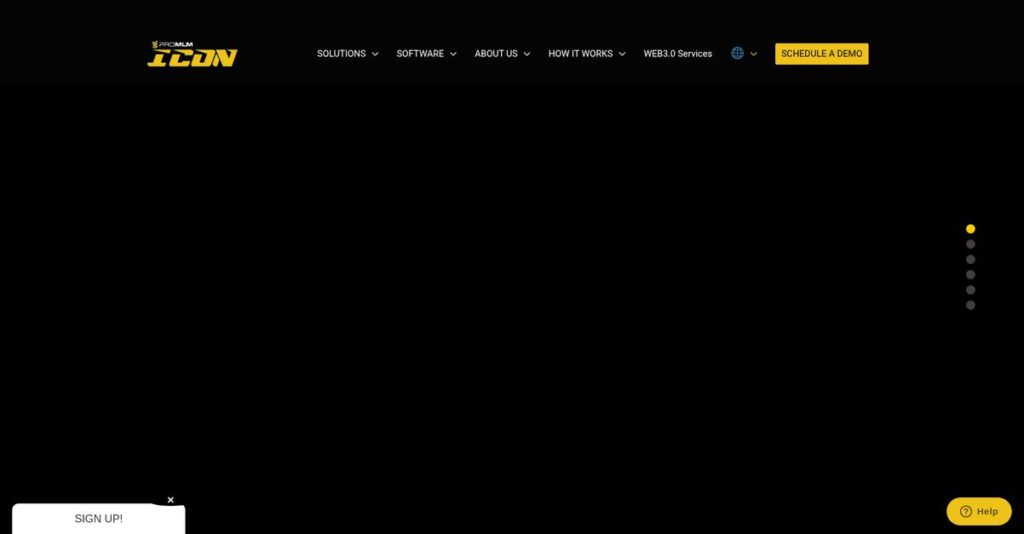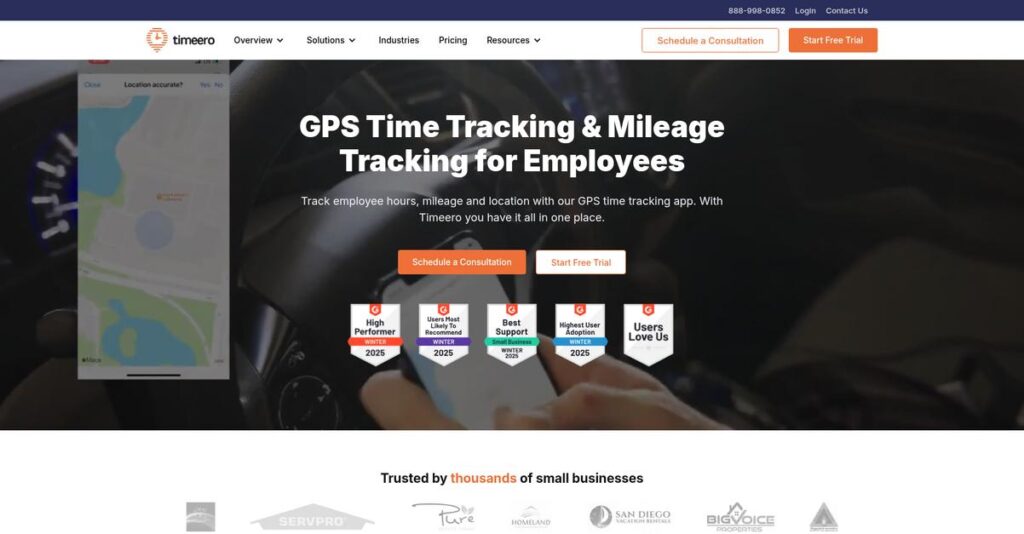Struggling to launch digital changes with confidence?
If you’re looking into Optimizely, you probably need a way to test ideas and deliver content faster—without bottlenecks from IT or endless guesswork.
But here’s the reality: not knowing what’s working on your site means you’re risking wasted time, missed revenue, and marketing efforts that just don’t land.
I’ve dug deep into Optimizely’s all-in-one platform to see how it lets you experiment, personalize, and manage digital experiences across your site—all from one place—so you can actually see what’s making a difference.
In this review, I’ll explain how you can finally run smarter, data-backed campaigns with less hassle and more control.
You’ll find out, in this Optimizely review, how the platform stacks up on features, pricing, ease of use, and how it compares to alternatives when you’re making your shortlist.
You’ll walk away with the features you need to make a confident, informed decision—no more second-guessing.
Let’s get started.
Quick Summary
- Optimizely is a digital experience platform that helps businesses run experiments, personalize content, and manage commerce in one system.
- Best for mid-market to enterprise companies needing integrated experimentation, content, and e-commerce solutions.
- You’ll appreciate its strong A/B testing tools combined with a user-friendly CMS that empowers marketers without heavy developer reliance.
- Optimizely offers custom pricing starting around $36,000 per year with no free trial, requiring direct sales contact for demos and quotes.
Optimizely Overview
Founded by ex-Googlers in 2010 and now based in New York, Optimizely’s mission is simple: helping businesses like yours test and perfect every single digital customer experience.
They primarily serve mid-market and enterprise companies needing an integrated digital experience platform. I think what truly defines them is their focus on unifying experimentation with content. This means you’re not just testing isolated pages; you’re optimizing entire customer journeys.
The acquisition by Episerver in 2020 was a pivotal moment, and a smart one in my opinion. It expanded their scope far beyond A/B testing, a key point to understand through this Optimizely review.
Unlike sprawling enterprise suites that can feel overwhelming, Optimizely is surprisingly accessible. They differentiate by delivering enterprise-grade power without the typical complexity, a balance I find your team will definitely appreciate.
- 🎯 Bonus Resource: If you’re also looking into optimizing specific business operations, my article on best glass industry software covers advanced solutions.
You’ll see them working with major enterprise and mid-market brands in retail, tech, and finance—organizations that must innovate quickly and prove the ROI of every digital dollar they spend.
From my analysis, their strategy is laser-focused on their unified ‘Optimizely One’ platform. They’re connecting content, commerce, and experimentation to give your team a single, cohesive workflow across the marketing lifecycle.
Now let’s examine their capabilities.
Optimizely Features
Struggling to deliver consistent digital experiences?
Optimizely solutions can help you create and optimize digital experiences across various channels. These are the five core Optimizely solutions that transform how you engage customers.
- 🎯 Bonus Resource: Speaking of streamlining operations, if you manage events, my guide on best event booking software can simplify your logistics.
1. Web Experimentation
Are your website changes just a shot in the dark?
Making website updates without knowing their impact can lead to wasted effort and missed opportunities. This means you might be losing conversions without even realizing it.
Optimizely’s Web Experimentation lets you test different versions of your pages or app interfaces to see what truly resonates. From my testing, the visual editor simplifies A/B and multivariate tests, even for multi-page funnels, without deep coding. This feature helps you continuously improve your site’s performance.
This means you can make data-driven decisions that directly boost your conversion rates and overall user engagement.
2. Feature Experimentation
Tired of risky, all-or-nothing feature rollouts?
Deploying new product features to everyone at once can introduce bugs and frustrate users. This often results in costly rollbacks and delays.
Feature Experimentation allows you to release new functionalities to specific user segments and monitor their performance. What I found impressive is how it decouples code deployment from feature release, reducing risk and enabling faster iteration. This solution is ideal for product teams and developers.
So you can safely test new ideas, quickly iterate based on feedback, and ensure a smooth, controlled launch for every new feature.
3. Content Cloud (CMS)
Is content creation slowing your marketing team down?
Reliance on developers for every content update can bottleneck your campaigns and prevent quick responses to market trends. This often means your content is outdated before it even goes live.
Content Cloud provides a user-friendly, component-based CMS with drag-and-drop functionality, empowering marketers to take control. This is where Optimizely shines; you can manage and reuse content across multiple sites and languages with ease. It also supports hyper-personalization, tailoring content to specific visitor groups.
This means your marketing team can rapidly publish and adapt content, ensuring your digital presence is always fresh and relevant to your audience.
4. Commerce Cloud
Struggling to create a unified buying experience online?
Managing content, products, and orders across separate systems can lead to disjointed customer journeys and operational inefficiencies. This makes scaling your e-commerce efforts incredibly difficult.
Commerce Cloud offers a unified platform for B2C and B2B digital shopping experiences, integrating content and commerce seamlessly. I found its scalability and AI-driven personalization capabilities truly stand out, offering tailored product recommendations. It simplifies complex catalogs and personalized pricing for B2B.
The result is you can deliver highly personalized, consistent customer journeys that boost sales and streamline your e-commerce operations.
5. Orchestrate
Are your marketing efforts fragmented across different tools?
Disconnected solutions often lead to silos, making it hard to create cohesive customer journeys and optimize the entire marketing lifecycle. This can prevent you from seeing the full picture of your customer interactions.
While specific details are less public, Orchestrate generally refers to Optimizely’s capabilities for seamless integration and coordination across its solutions. It enables unified workflows and data sharing, orchestrating customer journeys across content, commerce, and experimentation touchpoints. It’s the glue that holds everything together.
This means you get a truly connected ecosystem where all your digital experience efforts work in harmony, maximizing efficiency and impact.
Pros & Cons
- ✅ Market-leading A/B testing and advanced experimentation capabilities.
- ✅ Intuitive Content Cloud CMS for marketers with drag-and-drop.
- ✅ Robust personalization driven by AI for tailored user experiences.
- ⚠️ High entry cost and overall pricing may be prohibitive for smaller businesses.
- ⚠️ Broader DXP and advanced features can have a steep learning curve.
- ⚠️ Implementation can be lengthy and workflows occasionally rigid.
You’ll actually appreciate how these Optimizely features work together to create a unified digital experience platform rather than separate tools.
Optimizely Pricing
Worried about software costs spiraling out of control?
Optimizely pricing follows a custom quote model, meaning you’ll need to contact sales but also get pricing tailored to your specific needs.
Cost Breakdown
- Base Platform: Custom quote, estimated $36,000 USD/year starting
- User Licenses: Included in overall custom quote, not per-user
- Implementation: Varies, discussed with sales
- Integrations: Varies by complexity, discussed with sales
- Key Factors: Website traffic, features needed, business size, annual contracts
1. Pricing Model & Cost Factors
Understanding the cost structure.
Optimizely operates on a custom pricing model, meaning exact figures aren’t public. What I found regarding pricing is that your costs depend heavily on traffic volume, specific features (like Web or Feature Experimentation), and overall business needs. This also includes the Optimizely One platform components.
From my cost analysis, this means your costs are directly tied to your usage and the complexity of your digital experience requirements.
- 🎯 Bonus Resource: While we’re discussing complex digital requirements, understanding architectural CAD software is equally important.
2. Value Assessment & ROI
Is this an investment or an expense?
While Optimizely’s pricing is premium, its value lies in driving significant ROI through enhanced experimentation and personalization capabilities. This means your business can achieve higher conversion rates and improved customer experiences. The platform’s integrated DXP can reduce tool sprawl, ultimately optimizing your marketing budget.
Budget-wise, this helps you consolidate disparate tools into a unified platform, offering a strong return on your investment.
3. Budget Planning & Implementation
Consider total cost of ownership.
Beyond the annual subscription, consider potential costs for implementation, ongoing support, and internal team training. Optimizely typically requires annual contracts only, so be prepared for a long-term commitment. What impressed me about their pricing approach is how it aims to scale with your business growth, but be mindful of paying for unused capacity.
So for your business, plan for a significant annual investment, ensuring it aligns with your long-term growth and optimization goals.
My Take: Optimizely’s custom pricing positions it as a premium, enterprise-level solution. It’s best for large organizations serious about digital experience optimization and willing to invest in a powerful, integrated platform.
The overall Optimizely pricing reflects a significant investment for substantial digital transformation.
Optimizely Reviews
What do real customers actually think?
This customer reviews section analyzes real user feedback and experiences with Optimizely, providing balanced insights into what actual customers think about the software.
1. Overall User Satisfaction
Users are generally quite satisfied.
From my review analysis, Optimizely reviews show a clear pattern of strong satisfaction, particularly among enterprise users who leverage its full DXP capabilities. What impressed me is how many highlight its robust, sophisticated platform, affirming its power for complex digital needs.
This indicates you can expect a highly capable platform if your business fits its target market.
2. Common Praise Points
Its experimentation tools consistently shine.
Users frequently praise Optimizely’s market-leading A/B testing and experimentation features, including multivariate testing and advanced personalization. From the reviews I analyzed, the Content Cloud’s visual interface simplifies content management for marketers, accelerating campaign launches.
This means you can expect powerful tools for optimizing experiences and managing content efficiently.
3. Frequent Complaints
High cost is a significant barrier.
The most common complaint revolves around Optimizely’s high entry cost and overall pricing model, with many smaller businesses finding it prohibitive. What stood out in customer feedback is how the learning curve can be steep for advanced features, requiring experienced developers for optimal use.
These issues suggest you should carefully assess your budget and technical resources before committing.
- 🎯 Bonus Resource: Speaking of specialized business needs, my article on best garden center software can help businesses conquer seasonal demand.
What Customers Say
- Positive: “Optimizely’s A/B testing is unparalleled, giving us truly reliable data for decisions.” (G2 Reviewer)
- Constructive: “The pricing is definitely a barrier for mid-sized companies, even with its capabilities.” (Capterra User)
- Bottom Line:s “A powerful platform for large enterprises, but brace for the cost and complexity.” (Software Advice Review)
Overall, Optimizely reviews reflect a powerful platform for those who can afford its advanced capabilities and manage its complexity.
Best Optimizely Alternatives
What are the best Optimizely alternatives?
The best Optimizely alternatives include several strong options, each better suited for different business situations and priorities. I’ll help you navigate the competitive landscape.
- 🎯 Bonus Resource: Speaking of diverse technological solutions, you might find my guide on Best Quantum Computing Software helpful for your next project.
1. Adobe Experience Cloud
Already heavily invested in the Adobe ecosystem?
Adobe offers a more comprehensive analytics suite and a massive partner network, making it the enterprise solution for deeply integrated tools. From my competitive analysis, Adobe provides unparalleled comprehensive analytics capabilities, though its complexity and cost often require substantial budget and resources.
Choose Adobe if your organization needs the most comprehensive analytics for extremely complex, large-scale omnichannel experiences.
2. VWO (Visual Website Optimizer)
Seeking a more budget-friendly testing solution?
VWO is often positioned as a more affordable and accessible alternative, particularly for SMBs and mid-market companies focusing on conversion rate optimization tools. What I found comparing options is that VWO is more affordable for simpler needs, offering essential A/B testing and behavioral analytics at a lower price point.
Consider this alternative if you’re a smaller business or have simpler experimentation needs with lower traffic volumes.
3. Sitecore Digital Experience Platform
Your primary need is advanced content authoring?
Sitecore offers advanced and robust content authoring features, often considered more sophisticated for enterprise content marketers. From my analysis, Sitecore provides extremely advanced content capabilities, though its pricing is complex and often more costly with frequent upgrades.
Choose Sitecore if an extremely robust content authoring experience is paramount, and you have significant developer resources.
4. Statsig
Focusing purely on product development experimentation?
Statsig focuses exclusively on product development tools like A/B testing, feature flags, and analytics, processing massive event volumes with high uptime. Alternative-wise, Statsig offers enterprise-grade product experimentation, ideal when your focus is solely on A/B testing and feature flags within the product lifecycle.
Consider Statsig for product development teams needing enterprise-grade experimentation with transparent pricing and integrated analytics.
Quick Decision Guide
- Choose Optimizely: Comprehensive DXP for content, commerce, and experimentation
- Choose Adobe Experience Cloud: Deeply integrated with Adobe ecosystem for complex enterprises
- Choose VWO: Budget-friendly A/B testing for SMBs with simpler needs
- Choose Sitecore: Advanced content authoring for large enterprises
- Choose Statsig: Product-centric A/B testing and feature flagging
The best Optimizely alternatives ultimately depend on your business size, specific needs, and budget more than a universal “best.”
Optimizely Setup
Ready for Optimizely implementation realities?
This Optimizely review dives into the practical aspects of deployment, from initial setup to long-term adoption, setting realistic expectations for your team.
1. Setup Complexity & Timeline
Getting Optimizely up and running.
Optimizely implementation ranges from simple snippet pasting for Web Experimentation to more involved DXP deployments, which can take many months. What I found about deployment is that enterprise-level rollouts often entail lengthy timelines, so manage your expectations regarding a quick turnaround.
You’ll need dedicated project planning and resource allocation to navigate the varying complexities involved.
- 🎯 Bonus Resource: While we’re discussing operational efficiency, my article on best golfcourse software covers specialized solutions.
2. Technical Requirements & Integration
Beyond just the software, there are technical demands.
Optimizely operates as a cloud-based SaaS, built on Microsoft Azure, ensuring scalability and performance for your digital experiences. From my implementation analysis, integration via open APIs is crucial for connecting with existing ERPs, PIMs, or marketing automation systems.
Your IT team will need to ensure smooth integration capabilities and understand the SDKs for developer-centric features.
3. Training & Change Management
Ensuring your team actually uses the platform.
While the Content Cloud boasts intuitive drag-and-drop features for marketers, advanced DXP functionalities and Feature Experimentation require more in-depth training. From my analysis, successful change management hinges on proactive user training to overcome any initial learning curves.
Invest in training programs and identify internal champions to foster widespread adoption and maximize your team’s productivity.
4. Support & Success Factors
How well will you be supported during deployment?
Optimizely offers community, academy, and online ticket support, alongside frequent backward-compatible upgrades to ensure ongoing product improvement. What I found about deployment is that proactive engagement with available support resources can significantly smooth out any bumps in your implementation journey.
Plan to leverage their continuous upgrade model and support channels for a more resilient and future-proof deployment.
Implementation Checklist
- Timeline: Weeks for Web, 6-12+ months for full DXP
- Team Size: Marketing, IT, and dedicated project management
- Budget: Beyond software, consider professional services
- Technical: API integrations and potential SDK knowledge
- Success Factor: Clear scope definition and user training
The overall Optimizely setup requires realistic planning and cross-functional effort but can yield significant ROI when executed strategically.
Bottom Line
Should you invest in Optimizely?
My Optimizely review shows a powerful DXP for large organizations serious about digital experience optimization, but it demands a significant investment.
1. Who This Works Best For
Large enterprises driving extensive digital transformation.
Optimizely excels for mid-market to enterprise-level businesses with high traffic volumes, complex customer journeys, and substantial budgets for digital experience. From my user analysis, companies seeking integrated experimentation, content, and commerce find its comprehensive suite invaluable for scalable growth.
You’ll succeed if your focus is deep personalization and data-driven optimization across multiple digital touchpoints.
2. Overall Strengths
Advanced experimentation and intuitive content management.
The software succeeds by offering market-leading A/B testing and feature flagging alongside a user-friendly CMS that empowers marketing teams. From my comprehensive analysis, its AI-powered personalization capabilities stand out for delivering highly tailored customer experiences at scale, translating directly into higher conversion rates.
These strengths mean your teams can innovate faster, manage content efficiently, and drive significant ROI through optimized user journeys.
3. Key Limitations
Premium pricing and initial implementation complexity.
Optimizely’s primary drawback is its high cost, making it inaccessible for smaller businesses, with annual commitments starting around $36,000. Based on this review, the broader DXP can present a steeper learning curve beyond the intuitive CMS, potentially requiring experienced developers for full utilization.
I find these limitations crucial considerations, but they are often manageable for enterprise-level organizations with dedicated resources and long-term vision.
4. Final Recommendation
Optimizely earns a strong recommendation for specific users.
You should choose this software if your large enterprise prioritizes sophisticated experimentation, seamless content/commerce integration, and has a substantial budget for DXP. From my analysis, your business will thrive if it needs to scale personalized digital experiences and boost conversion rates across numerous channels.
My confidence level is high for large-scale operations, but I advise smaller businesses to explore more budget-friendly alternatives.
- 🎯 Bonus Resource: Speaking of optimizing performance and engagement, my guide on best sports league software covers solutions for boosting participation.
Bottom Line
- Verdict: Recommended for enterprise-level digital experience optimization
- Best For: Mid-market to enterprise businesses with high traffic and complex needs
- Business Size: Large organizations with substantial DXP budgets and dedicated teams
- Biggest Strength: Advanced experimentation, personalization, and integrated DXP capabilities
- Main Concern: High premium pricing and initial implementation complexity
- Next Step: Request a demo to assess fit with your comprehensive digital strategy
This Optimizely review shows strong value for enterprise-level businesses, while clearly highlighting the significant investment and commitment required for success.
